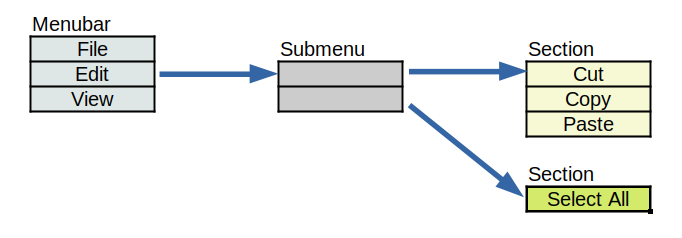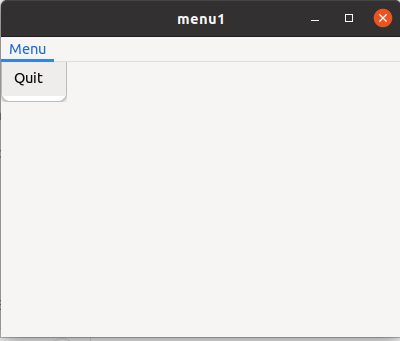
Up: index.html, Prev: Section 16, Next: Section 18
Users often use menus to tell a command to the computer. It is like this:

Now let’s analyze the menu above. There are two types of object.

Menus can build a complicated structure thanks to the links of menu items.
GMenuModel is an abstract object which represents a menu. GMenu is a simple implementation of GMenuModel and a child object of GMenuModel.
GObject -- GMenuModel -- GMenuBecause GMenuModel is an abstract object, it isn’t instantiatable. Therefore, it doesn’t have any functions to create its instance. If you want to create a menu, use g_menu_new to create a GMenu instance. GMenu inherits all the functions of GMenuModel because of the child object.
GMenuItem is an object directly derived from GObject. GMenuItem and Gmenu (or GMenuModel) don’t have a parent-child relationship.
GObject -- GMenuModel -- GMenu
GObject -- GMenuItemGMenuItem has attributes. One of the attributes is label. For example, there is a menu item which has “Edit” label in the first diagram in this section. “Cut”, “Copy”, “Paste” and “Select All” are also the labels of the menu items. Other attributes will be explained later.
Some menu items have a link to another GMenu. There are two types of links, submenu and section.
GMenuItem can be inserted, appended or prepended to GMenu. When it is inserted, all of the attributes and link values of the item are copied and used to form a new item within the menu. The GMenuItem itself is not really inserted. Therefore, after the insertion, GMenuItem is useless and it should be freed. The same goes for appending or prepending.
The following code shows how to append GMenuItem to GMenu.
GMenu *menu = g_menu_new ();
GMenuItem *menu_item_quit = g_menu_item_new ("Quit", "app.quit");
g_menu_append_item (menu, menu_item_quit);
g_object_unref (menu_item_quit);One of the attributes of menu items is an action. This attribute points an action object.
There are two action objects, GSimpleAction and GPropertyAction. GSimpleAction is often used. And it is used with a menu item. Only GSimpleAction is described in this section.
An action corresponds to a menu item will be activated when the menu item is clicked. Then the action emits an activate signal.
The following code is an example.
static void
quit_activated(GSimpleAction *action, GVariant *parameter, gpointer app) { ... ... ...}
GSimpleAction *act_quit = g_simple_action_new ("quit", NULL);
g_action_map_add_action (G_ACTION_MAP (app), G_ACTION (act_quit));
g_signal_connect (act_quit, "activate", G_CALLBACK (quit_activated), app);
GMenuItem *menu_item_quit = g_menu_item_new ("Quit", "app.quit");menu_item_quit is a menu item. It has a label “Quit” and is connected to an action “app.quit”. “app” is a prefix and “quit” is a name of the action. The prefix “app” means that the action belongs to a GtkApplication instance. If the menu is clicked, then the corresponding action “quit” which belongs to the GtkApplication will be activated.act_quit is an action. It has a name “quit”. The function g_simple_action_new creates a stateless action. So, act_quit is stateless. The meaning of stateless will be explained later. The argument NULL means that the action doesn’t have an parameter. Most of the actions are stateless and have no parameter.act_quit is added to the GtkApplication instance with g_action_map_add_action. When act_quit is activated, it will emit “activate” signal.quit_activated. So, if the action is activated, the handler will be invoked.The following is a simple example of menus and actions.
#include <gtk/gtk.h>
static void
quit_activated(GSimpleAction *action, GVariant *parameter, gpointer user_data) {
GApplication *app = G_APPLICATION (user_data);
g_application_quit (app);
}
static void
app_activate (GApplication *app, gpointer user_data) {
GtkWidget *win = gtk_application_window_new (GTK_APPLICATION (app));
gtk_window_set_title (GTK_WINDOW (win), "menu1");
gtk_window_set_default_size (GTK_WINDOW (win), 400, 300);
GSimpleAction *act_quit = g_simple_action_new ("quit", NULL);
g_action_map_add_action (G_ACTION_MAP (app), G_ACTION (act_quit));
g_signal_connect (act_quit, "activate", G_CALLBACK (quit_activated), app);
GMenu *menubar = g_menu_new ();
GMenuItem *menu_item_menu = g_menu_item_new ("Menu", NULL);
GMenu *menu = g_menu_new ();
GMenuItem *menu_item_quit = g_menu_item_new ("Quit", "app.quit");
g_menu_append_item (menu, menu_item_quit);
g_object_unref (menu_item_quit);
g_menu_item_set_submenu (menu_item_menu, G_MENU_MODEL (menu));
g_menu_append_item (menubar, menu_item_menu);
g_object_unref (menu_item_menu);
gtk_application_set_menubar (GTK_APPLICATION (app), G_MENU_MODEL (menubar));
gtk_application_window_set_show_menubar (GTK_APPLICATION_WINDOW (win), TRUE);
gtk_window_present (GTK_WINDOW (win));
/* gtk_widget_show (win); is also OKay instead of gtk_window_present. */
}
#define APPLICATION_ID "com.github.ToshioCP.menu1"
int
main (int argc, char **argv) {
GtkApplication *app;
int stat;
app = gtk_application_new (APPLICATION_ID, G_APPLICATION_FLAGS_NONE);
g_signal_connect (app, "activate", G_CALLBACK (app_activate), NULL);
stat =g_application_run (G_APPLICATION (app), argc, argv);
g_object_unref (app);
return stat;
}quit_activated is a handler of the “activate” signal on the action act_quit. Handlers of the “activate” signal have three parameters.
NULL because the second argument of g_simple_action_new (line 15) is NULL. You don’ t need to care about it.g_signal_connect (line 18) that connects the action and the handler.g_application_quit immediately quits the application.app_activate is a handler of “activate” signal on the GtkApplication instance.win. And sets the title and the default size.act_quit. It is stateless. The first argument of g_simple_action_new is a name of the action and the second argument is a parameter. If you don’t need the parameter, pass NULL. Therefore, act_quit has a name “quit” and no parameter.app. GtkApplication implements an interface GActionMap and GActionGroup. GtkApplication (GActionMap) can have a group of actions and the actions are added with the function g_action_map_add_action. This function is described in Gio API Reference, g_action_map_add_action.quit_activated.menubar and menu are GMenu. menu_item_menu and menu_item_quit are GMenuItem. menu_item_menu has a label “Menu” and no action. menu_item_quit has a label “Quit” and an action “app.quit”. The action “app.quit” is a combination of “app” and “quit”. “app” is a prefix and it means that the action belongs to GtkApplication. “quit” is the name of the action. Therefore, “app.quit” points the action which belongs to the GtkApplication instance and is named “quit”.menu_item_quit to menu. As I mentioned before, all the attributes and links are copied and used to form a new item in menu. Therefore after the appending, menu_item_quit is no longer needed. It is freed by g_object_unref.menu_item_menu to point menu.menu_item_menu to menubar. Then frees menu_item_menu. GMenu and GMenuItem are connected and finally a menu is made up. The structure of the menu is shown in the diagram below.

Up: index.html, Prev: Section 16, Next: Section 18